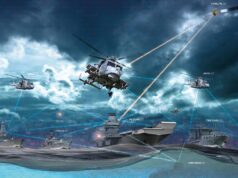The contractor will provide their own ‘adversary’ jets to perform air-to-air combat training for the Royal Air Force.
Sound familiar? This is effectively a relaunch of the ASDOT programme. ASDOT would have seen British pilots trained against jets supplied by industry partners, however the contract was halted in 2019 with no winner selected. One of the selling points of the contract was that it would eliminate maintenance and storage costs of the aircraft used, with the MoD only paying for the time it worked with the aircraft.
Another plus would have been that the aircraft used would likely have been different to those operated by British pilots, providing experience of working with or against aircraft types not in use by British forces. You can read more about ASDOT here.
Anyway, here are the basics from the information notice published by the Ministry of Defence on the new programme.
“This notice is for the purpose of informing potential suppliers of the intended procurement of a medium to fast speed Operational Readiness Training (ORT) aerial support service, to include Air-to-Air, Target, Threat Simulation and Mission Augmentation training.
This is an urgent requirement for the RAF and the intention is to utilise the DSPCR Competitive Procedure with Negotiation, using the accelerated timescales.
Due to the security classification of this project, and in accordance with Reg 6(3A)(a) of DSPCR, any potential competition that follows this PIN will be limited to those suppliers that can provide the requirement with employees who are UK nationals.
We are looking to hear from companies that can commit to:
- Delivery of an estimated 2400 flying hours (per annum) with a maximum of 4 simultaneous sortie rate and up to 12 sorties daily in a 15 hour flying window
- CAA or MAA accreditation for the proposed aircraft and activities
- Available to commence contract activities from a UK base within a 30 minute transit time to D323 North Sea training complex
- Operations able to commence Summer 2022″
The value of the contract is expected to be £100 million.














This seems like the perfect capability to set up multinationally. I wonder if the government has considered establishing a NATO adversary combat training facility? This would potentially mean access to a wider array of opposing platforms, cost efficiencies at scale, and ability to learn lessons from allies.
They need to be UK based to support the UK ranges and training areas. The Canadian Discovery fleet are also used by Germany, I believe..
Would make perfect sense to be a shared international capability with higher utilisation across multiple airforces. …Albeit with capability to fwd deploy to different bases / training regions….as the hawks did in 2020 for Joint Warrior
It’s the “Top Aces” group wiht a fleet of Alpha Jets, A-4s, F-16s. they are training the Germans, the USAF, RCAF
Decimomannu Air Base – Wikipedia
I wonder if there will be a similar contract for the RN? I had hoped ASDOT would see civilian fast jets operating alongside the Falcon 20’s at Bournemouth. I guess if Draken win this new contract they would operate out of Teeside, Bournemouth i guess is a bit too far south 🙁
I think it is for both RAF and RN.
I thought Draken also operate out of Bournemouth?
They do, but I believe their work is mainly for the RN in the channel, Draken also have jets up north. I’m not sure that Bournemouth will be within the 30 transit time to the training area mentioned.
Do you know where they’ll operate the F16s they’re acquiring?
ASDOT to aggressor Typhoons and now back to something ASDOT shaped again. Maybe it wouldn’t be so urgent if the MoD didn’t decide to ditch its existing Hawks and Typhoons first and then realise they still need to plug the gap!
Agreed and not before 2035 in my opinion particularly for Typhoon T1’s. Hopefully, Tempest will be up and running by then.
“Pointing to the aggressive schedule of the FCAS venture, he notes: “We need to maintain pace with our adversaries – we struggle to do that at the moment.”
https://www.flightglobal.com/defence/new-mindset-the-key-to-tempest-success-partners-say/145584.article
This kind of dithering costs us dearly not just financially, but in lost time and capability. Its this kind of indecision that led to us failing to recapitalise our vehicle fleet. Trying to hang onto tranche 1 Typhoons of marginal usefulness, which use up urgently needed fast jet pilots and are costly to operate as aggressors – is not the way forward – I imagine the RAF were told to divest old and expensive to operate fleets of legacy platforms and invest in the next generation – it seems to be a theme across the services post IR.
Without Typhoon T! and Hawk to worry about a lot more pilots become available to sustain the Typhoon fleet and expand the F-35 fleet. Operating costs for small fleets like these will be high – not benefitting from scale and the older airframes having greater maintenance needs and lower availability. An ASDOT type solution – which will probably require UK national aircrew – will be a great opportunity for retiring RAF personnel to move into commercial. Companies like Drakken and Discovery have already invested in large aggressor fleets and have the global support solutions.
Are the older Typhoon’s not good enough or too costly to retain as aggressors or a bit of both?
Nothing against an ASDOT type solution if it ended up being cost effective and offering the same level of capability. It’s the back to front and chaotic decision making that’s the bigger issue, with replacement systems delayed and then legacy kit offered up as sacrificial lambs in the next round of cuts.
The costings are all a bit of a red herring – to avoid maintenance and storage costs. These costs will be factored into the required ‘hire time’ for the required flying hours.
It’s the usual argument between CAPEX and OPEX – standing up an internal aggressor squadron requires an up-front capital investment (either a direct cost of purchasing jets, or indirectly by taking jets away from frontline duties leaving a gap in capability/numbers).
Contracting it out amortizes that cost across the “hire time” as you point out, but it also serves to reduce the sticker shock, and more importantly, it’s easier to fund from a budget subject to constant SDSRs.
On the human side, one can hope that in such a model, talented pilots find their way into private sector companies providing such services, rather than losing them to the commercial sector.
Use the Typhoon Tranche1’s 🙂 sell them to the winner
They would be to expensive to operate for a private company.
Less so for BAe
Civilian contractors operate a good many things more highly classified than the internals of s Typhoon intake.
HHA could be expanding then! That would be nice.
When will the MoD and other government contractors learn that this does not lead to efficiency savings….
Greece and Turkey have found a creative way to supply each other with this service for free over the years, maybe we could do the same with France over the channel.
I just can’t see how this could be done and save money unless it’s very multinational!
The costs of running the jets and paying staff still exist plus a profit will be needed on top of it.
To set that up for the uk only will end up costing more than the RAF running it’s own aggressors.
Love the fact its an urgent requirement. Aka we’ve cut something before we have thought about what will replace it. Business as usual.
In this case I think contractor owned / operated is a good idea. There are companies like Draken which have invested in large fleets and have a support structure. They have a small air force including 30 ex-Polish and Czech MIG21Bis, 21 ex French Mirage F1, 12 ex SAAF Atlas Cheetah (Mirage III upgraded with IAI Kfir avionics), 13 ex-RNZAF A-4K Skyhawks and 23 new build Aero L-1159 Alca trainers. They also operate the ex-RN Dassault Falcon taget tugs (stil owned by MOD) in the UK.
They can offer really dissimilar adversaries and a range of different types.
Love the skull and cross bones!!
Sorry, not a technical post.
I read an article on the UK firm that operates Hawker Hunters. They said it is easier to operate (in the UK) with a jet that has been in UK military service, as the regulators have experience of it. So go round the world looking for second hand Hawks & Jaguars with reasonable hours left on them.
Hunters are still operated in the USA in support of their armed forces I believe.
Concorde used reheat to take off from Heathrow.
This is a great idea and when they’re not going up against the RAF they can give paid joyrides to the public to supplement their income and maybe I can finally get a go in a fast jet
I had a an idea that countries band together to provide it. Say UK, France, Netherlands, Belgium, Norway, Sweden for example.
That way all the countries pilots get maximum training in multiple roles against multiple types.
Is there a reason this couldn’t be done and wouldn’t be beneficial
I wonder if Draken Europe plan to buy some of 100SQN Hawk T.1?